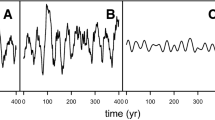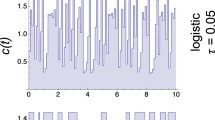Abstract
Experiments with the flour beetle Tribolium have revealed that animal numbers were larger in cultures grown in a periodically fluctuating volume of medium than in cultures grown in a constant volume of the same average size. In this paper we derive and analyze a discrete stage-structured mathematical model that explains this phenomenon as a kind of resonance effect. Habitat volume is incorporated into the model by the assumption that all rates of cannibalism (larvae on eggs, adults on eggs and pupae) are inversely proportional to the volume of the culture medium. We tested this modeling assumption by conducting and statistically analyzing laboratory experiments. For parameter estimates derived from experimental data, our model indeed predicts, under certain circumstances, a larger (cycle-average) total population abundance when the habitat volume periodically fluctuates than when the habitat volume is held constant at the average volume. The model also correctly predicts certain phase relationships and transient dynamics observed in data. The analyses involve a thorough integration of mathematics, statistical methods, biological details and experimental data.
Similar content being viewed by others
References
Barbosa, P. and J. C. Shultz (1987). Insect Outbreaks, New York: Academic Press.
Bardi, M. (1983). An equation of growth of a single species with realistic dependence on crowding and seasonal factors. J. Math. Biol. 17, 33–43.
Caswell, H. and M. C. Trevisan (1991). Sensitivity analysis of periodic matrix models. Ecology 75, 1299–1303.
Costantino, R. F. and R. A. Desharnais (1991). Population Dynamics and the Tribolium Model: Genetics and Demography, New York: Springer-Verlag.
Costantino, R. F., J. M. Cushing, B. Dennis and R. A. Desharnais (1995). Experimentally induced transitions in the dynamic behavior of insect populations. Nature 375, 227–230.
Costantino, R. F., R. A. Desharnais, J. M. Cushing and B. Dennis (1997). Chaotic dynamics in an insect population. Science 275, 389–391.
Crombie, A. C. (1943). The effect of crowding upon the natality of grain-infesting insects. Proc. Zool. Soc. Lond. A 113, 77–98.
Cushing, J. M. (1977). Periodic time-dependent predator prey systems. SIAM J. Appl. Math. 23, 972–979.
Cushing, J. M. (1982). Periodic Kolomogov systems. SIAM J. Math. Anal. 13, 811–827.
Cushing, J. M. (1984). Periodic two-predator, one-prey interactions and the time sharing of a resource niche. SIAM J. Appl. Math. 44, 392–410.
Cushing, J. M. (1986). Periodic Lotka-Volterra competition equations. J. Math. Biol. 24, 381–403.
Cushing, J. M. (1987). Oscillatory population growth in periodic environments. Theor. Pop. Biol. 30, 289–308.
Cushing, J. M. (1995). Systems of difference equations and structured population dynamics, in Proceedings of the First International Conference on Difference Equations (N. Saber, R. Elaydi, G. L. Graef, A. C. Peterson, (eds), Gordon and Breach Publishers, pp. 123–132.
Cushing, J. M. (1998). Periodically forced nonlinear systems of difference equations. J. Difference Equations & Applications, in press.
Cushing, J. M., B. Dennis, R. A. Desharnais and R. F. Costantino (1996). An interdisciplinary approach to understanding nonlinear ecological dynamics. Ecol. Modelling 92, 111–119.
Cushing, J. M., B. Dennis, R. A. Desharnais and R. F. Costantino (1998). Moving toward an unstable equilibrium: saddle nodes in population systems. J. Anim. Ecol., in press.
deMottoni, P. and A. Schiaffino (1982). Competition systems with periodic coefficients: a geometrical approach. J. Math. Biol. 11, 319–335.
Dennis, B. and R. F. Costantino (1988). Analysis of steady-state populations with the gamma abundance model: application to Tribolium. Ecology 69, 1200–1213.
Dennis, B., P. L. Munholland and J. M. Scott (1991). Estimation of growth and extinction parameters for endangered species. Ecol. Monogr. 61, 115–143.
Dennis, B., R. A. Desharnais, J. M. Cushing and R. F. Costantino (1995). Nonlinear demographic dynamics: mathematical models, statistical methods, and biological experiments. Ecol. Monogr. 65, 261–281.
Dennis, B., R. A. Desharnais, J. M. Cushing and R. F. Costantino (1997). Transitions in population dynamics: equilibria to periodic cycles to aperiodic cycles. J. Anim. Ecol. 66, 704–729.
Fretwell, S. D. (1972). Populations in a Seasonal Environment, Princeton: Princeton University Press.
Henson, S. M. (1996). Existence and stability of nontrivial periodic solutions of periodically forced discrete dynamical systems. J. Difference Equations & Applications 2, 315–331.
Henson, S. M. and J. M. Cushing (1997). The effect of periodic habitat fluctuations on a nonlinear insect population model. J. Math. Biol. 36, 201–226.
Jillson, D. A. (1980). Insect populations respond to fluctuating environments. Nature 288, 699–700.
Klimko, L. A. and P. I. Nelson (1978). On conditional least squares estimation for stochastic processes. Ann. Statistics 6, 629–642.
Koch, A. L. (1974). Competitive coexistence of two predators utilizing the same prey under constant environmental conditions, J. Theor. Biol. 44, 373–386.
Landahl, H. D. (1955). A mathematical model for the temporal pattern of a population structure, with particular reference to the flour beetle. Bull. Math. Biophys. 17, 63–77.
Lloyd, M. (1968). Self regulation of adult numbers of cannibalism in two laboratory strains of flour beetles (Tribolium castaneum), Ecology 49, 245–259.
MacArthur, R. H. (1968). Selection for life tables in periodic environments. Am. Nat. 102, 181–189.
McFadden, C. S. (1991). A comparative demographic analysis of clonal reproduction in a temperate soft coral. Ecology 72, 1849–1866.
Mertz, D. B. and R. B. Davies (1968). Cannibalism of the pupal stage by adult flour beetles: An experiment and a stochastic model. Biometrics 24, 247–275.
May, R. M. (1973). Stability and Complexity in Model Ecosystems, Princeton University Press.
May, R. M. (Ed.) (1976). Theoretical Ecology. W. B. Saunders, p. 23.
Morris, R. F. (1963). The dynamics of epidemic spruce budworm populations. Mem. Entomol. Can. 31, 1–332.
Neyman, J., T. Park and E. L. Scott (1956). Struggle for existence, the Tribolium model: Biological and statistical aspects. In: Neyman, J. (ed) Proc. Third Berkely Symp. Stat. Prob., Univ. California Press, pp. 41–79.
Namba, T. (1984). Competitive co-existence in a seasonally fluctuating environment. J. Theor. Biol. 111, 369–386.
Nisbet, R. M. and W. S. C. Gurney (1976). Population dynamics in a periodically varying environment. J. Theor. Biol. 56, 459–475.
Nisbet, R. M. and W. S. C. Gurney (1982). Modelling Fluctuating Populations. New York: John Wiley.
Park, T., J. R. Ziegler, D. L. Ziegler and D. B. Mertz (1974). The cannibalism of eggs by Tribolium larvae. Physiol. Zool. 47, 37–58.
Press, W. H., B. P. Flannery, S. A. Teukolsky and W. T. Vetterling (1992). Numerical Recipes: The Art of Scientific Computing, Cambridge: Cambridge University Press.
Read, T. R. C. and N. A. C. Cressie (1988). Goodness-of-fit Statistics for Discrete Multivariate Data, New York: Springer Verlag.
Renshaw, E. (1989). Modelling Biological Populations in Space and Time, Cambridge: Cambridge University Press.
Rosenblat, S. (1980). Population models in a periodically fluctuating environment. J. Math. Biol. 9, 23–36.
Serfling, R. J. (1980). Approximation Theorems of Mathematical Statistics, New York: John Wiley.
Smith, H. L. (1981). Competitive coexistence in an oscillating chemostat. SIAM J. Appl. Math. 40, 498–522.
Smith, H. L. and P. Waltman (1995). The Theory of the Chemostat: Dynamics of Microbial Competition, Cambridge: Cambridge University Press.
Stanley, J. (1932). A mathematical theory of the growth of populations of the flour beetle, Tribolium confusum, Duv. Can. J. Res. 6, 632–671.
Tong, H. (1990). Nonlinear Time Series: A Dynamical System Approach, Oxford: Oxford University Press.
Tuljapurkar, S. D. (1990). Population Dynamics in Variable Environments, New York: Springer-Verlag.
Wellington, W. G. (1964). Qualitative changes in populations in unstable environments. Can. Entomol. 96, 436–451.
Author information
Authors and Affiliations
Corresponding author
Rights and permissions
About this article
Cite this article
Costantino, R.F., Cushing, J.M., Dennis, B. et al. Resonant population cycles in temporally fluctuating habitats. Bull. Math. Biol. 60, 247–273 (1998). https://doi.org/10.1006/bulm.1997.0017
Received:
Accepted:
Issue Date:
DOI: https://doi.org/10.1006/bulm.1997.0017




